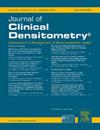躯干区域体成分对腰椎骨矿物质含量和密度的影响
IF 1.6
4区 医学
Q4 ENDOCRINOLOGY & METABOLISM
引用次数: 0
摘要
背景:本研究的目的是探讨躯干区域身体组成(特别是脂肪量(FM)和瘦质量(LM))对腰椎骨密度(BMD)和骨矿物质含量(BMC)的差异影响,重点关注性别和绝经状态的变化。材料和方法:我们确定了331名成年患者(69名男性,161名绝经前女性和101名绝经后女性),他们接受了双能x线吸收仪(DXA),同时测量躯干成分和腰椎骨密度(L2-L4)。使用Pearson相关系数评估身体组成成分与腰椎BMD和BMC之间的线性关系,并按性别和绝经状态分层。此外,采用多元线性回归分析和正向逐步消去程序来寻找合理的预测变量子集。结果:男性、绝经后和绝经前个体的身体成分与骨密度之间的相关系数最高的区域如下:骨盆脂肪量(r = 0.325;P <; 0.01),胸瘦质量(r = 0.260;P <; 0.01),总瘦质量(r = 0.312;分别P & lt; 0.01)。此外,总瘦质量(r = 0.477;P <; 0.01),胸瘦质量(r = 0.360;P <; 0.01),总瘦体重(r = 0.459;体成分与BMC的相关系数为P <; 0.01)。前向逐步回归发现年龄、胸部瘦质量和腹部脂肪质量是绝经后妇女BMC的预测因素;绝经前妇女的身体质量指数和总瘦体重;以及男性的总瘦体重。对于骨密度,胸瘦质量(绝经后)、总瘦质量(绝经前)和BMI(男性)是显著的预测因子。结论:脂肪量不影响骨密度或BMC,而瘦质量强烈预测骨骼健康。躯干身体组成与骨密度和BMC的关系各不相同,这使得确定胸部和腹部的瘦质量分布如何具体影响骨骼健康变得具有挑战性。本文章由计算机程序翻译,如有差异,请以英文原文为准。
The role of trunk region body composition in lumbar spine bone mineral content and density
Background: The aim of this study was to investigate the differential effects of trunk region body composition—specifically fat mass (FM) and lean mass (LM)—on lumbar spine bone mineral density (BMD) and bone mineral content (BMC), with a focus on variations by gender and menopausal status.
Materials and Methods: We identified 331 adult patients (69 men, 161 premenopausal women, and 101 postmenopausal women) who underwent dual-energy X-ray absorptiometry (DXA) to simultaneously measure trunk body composition and lumbar spine BMD (L2-L4). The Pearson correlation coefficient was used to assess the linear relationships between body composition components and lumbar spine BMD and BMC, stratified by gender and menopausal status. Additionally, multiple linear regression analysis with the forward stepwise elimination procedure was applied to find a reasonable subset of predictor variables.
Result: The highest correlation coefficients between body composition and BMD were seen for men and post- and premenopausal individuals in the following areas: pelvic fat mass (r = 0.325; P < 0.01), chest lean mass (r = 0.260; P < 0.01), and total lean mass (r = 0.312; P < 0.01), respectively. Additionally, total lean mass (r = 0.477; P < 0.01), chest lean mass (r = 0.360; P < 0.01), and total lean mass (r = 0.459; P < 0.01) had the strongest correlation coefficients between body composition and BMC. Forward stepwise regression identified age, chest lean mass, and midriff fat mass as predictors of BMC in postmenopausal women; BMI and total lean mass in premenopausal women; and total lean mass in men. For BMD, chest lean mass (postmenopausal), total lean mass (premenopausal), and BMI (men) were significant predictors.
Conclusions: Fat mass does not affect BMD or BMC, while lean mass, strongly predicts bone health. Trunk body composition showed varying relationships with BMD and BMC, making it challenging to pinpoint how lean mass distribution in the chest and midriff specifically impacts bone health.
求助全文
通过发布文献求助,成功后即可免费获取论文全文。
去求助
来源期刊

Journal of Clinical Densitometry
医学-内分泌学与代谢
CiteScore
4.90
自引率
8.00%
发文量
92
审稿时长
90 days
期刊介绍:
The Journal is committed to serving ISCD''s mission - the education of heterogenous physician specialties and technologists who are involved in the clinical assessment of skeletal health. The focus of JCD is bone mass measurement, including epidemiology of bone mass, how drugs and diseases alter bone mass, new techniques and quality assurance in bone mass imaging technologies, and bone mass health/economics.
Combining high quality research and review articles with sound, practice-oriented advice, JCD meets the diverse diagnostic and management needs of radiologists, endocrinologists, nephrologists, rheumatologists, gynecologists, family physicians, internists, and technologists whose patients require diagnostic clinical densitometry for therapeutic management.
 求助内容:
求助内容: 应助结果提醒方式:
应助结果提醒方式:


